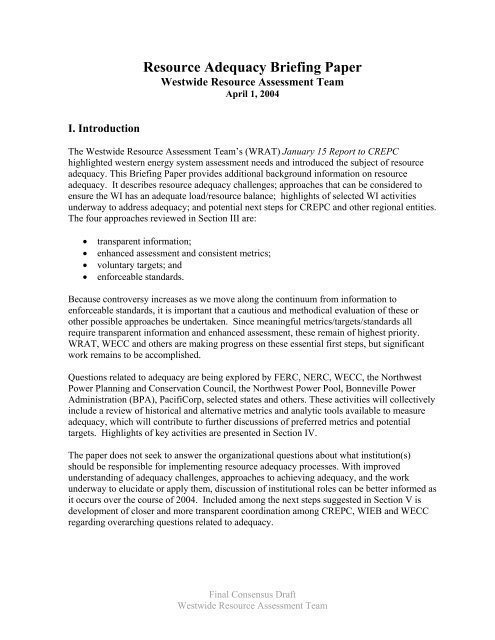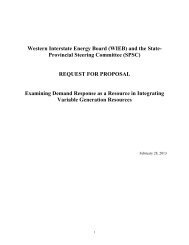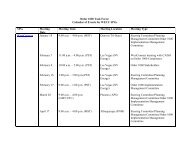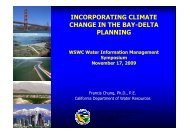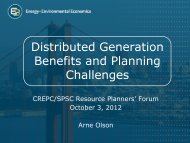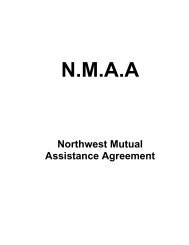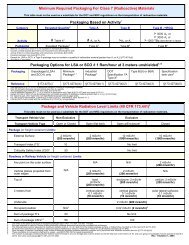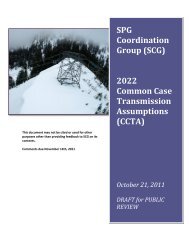WRAT Final Briefing Paper - Western Governors' Association
WRAT Final Briefing Paper - Western Governors' Association
WRAT Final Briefing Paper - Western Governors' Association
Create successful ePaper yourself
Turn your PDF publications into a flip-book with our unique Google optimized e-Paper software.
Resource Adequacy <strong>Briefing</strong> <strong>Paper</strong><br />
Westwide Resource Assessment Team<br />
April 1, 2004<br />
I. Introduction<br />
The Westwide Resource Assessment Team’s (<strong>WRAT</strong>) January 15 Report to CREPC<br />
highlighted western energy system assessment needs and introduced the subject of resource<br />
adequacy. This <strong>Briefing</strong> <strong>Paper</strong> provides additional background information on resource<br />
adequacy. It describes resource adequacy challenges; approaches that can be considered to<br />
ensure the WI has an adequate load/resource balance; highlights of selected WI activities<br />
underway to address adequacy; and potential next steps for CREPC and other regional entities.<br />
The four approaches reviewed in Section III are:<br />
• transparent information;<br />
• enhanced assessment and consistent metrics;<br />
• voluntary targets; and<br />
• enforceable standards.<br />
Because controversy increases as we move along the continuum from information to<br />
enforceable standards, it is important that a cautious and methodical evaluation of these or<br />
other possible approaches be undertaken. Since meaningful metrics/targets/standards all<br />
require transparent information and enhanced assessment, these remain of highest priority.<br />
<strong>WRAT</strong>, WECC and others are making progress on these essential first steps, but significant<br />
work remains to be accomplished.<br />
Questions related to adequacy are being explored by FERC, NERC, WECC, the Northwest<br />
Power Planning and Conservation Council, the Northwest Power Pool, Bonneville Power<br />
Administration (BPA), PacifiCorp, selected states and others. These activities will collectively<br />
include a review of historical and alternative metrics and analytic tools available to measure<br />
adequacy, which will contribute to further discussions of preferred metrics and potential<br />
targets. Highlights of key activities are presented in Section IV.<br />
The paper does not seek to answer the organizational questions about what institution(s)<br />
should be responsible for implementing resource adequacy processes. With improved<br />
understanding of adequacy challenges, approaches to achieving adequacy, and the work<br />
underway to elucidate or apply them, discussion of institutional roles can be better informed as<br />
it occurs over the course of 2004. Included among the next steps suggested in Section V is<br />
development of closer and more transparent coordination among CREPC, WIEB and WECC<br />
regarding overarching questions related to adequacy.<br />
<strong>Final</strong> Consensus Draft<br />
Westwide Resource Assessment Team
II. Resource Adequacy Challenges<br />
To enable the reader to understand why a resource adequacy challenge exists, it is first useful<br />
to explore what problems we are attempting to solve. In the following sub-sections we focus<br />
particularly on the incentive problems and conflicts that exist today and that have the potential<br />
to contribute to inadequate resource development.<br />
II.A The WI Lacks a Common Understanding or Definition of Resource Adequacy<br />
The region does not have a common understanding or agreement on definition(s) of<br />
adequacy. 1 While we do agree it is one key element of overall system reliability, its<br />
relationship to other components of reliability such as system operation or transmission<br />
development is not well recognized. Even the term ‘reliability’ itself means different things to<br />
different people, and we therefore do not have good measurements of it or the costs associated<br />
with achieving, or failing to achieve, varying levels of it. In the absence of a common<br />
understanding of terms or goals it is difficult to have an informed discussion, or to approach<br />
the challenge of achieving consensus.<br />
The CREPC Reliability Working Group’s January 15 Report makes an important initial<br />
contribution by its discussion of various concepts of reliability. It emphasizes that most<br />
people perceive “reliability” as the absence of power failures, and it notes that there are at<br />
least three kinds of failures:<br />
(1) Localized failures due to problems in the distribution system.<br />
(2) Cascading outages caused by operational problems or system element failures in<br />
the interconnected transmission system.<br />
(3) Power failures from not having adequate generating capacity available or the<br />
inability to fuel generators under extreme conditions.<br />
It is the third of these reliability challenges that the <strong>WRAT</strong> discusses in this paper: generation<br />
resource availability and its balance with load and demand reduction/response needs. 2 Power<br />
failures associated with lack of adequacy of the capacity of the system are currently the<br />
responsibility of individual load serving entities and their regulators, but system operators<br />
such as the ISO or any future RTOs can also be greatly affected by, or considered responsible<br />
for, outages and their impacts. <strong>Final</strong>ly, inevitably, it is the elected officials who answer to the<br />
voters for availability and cost of electricity<br />
A more detailed definition of resource adequacy can be found in the CREPC survey of<br />
member organizations conducted in March 2003:<br />
1 For the purposes of this paper, the region is defined as the geographic footprint of the WI.<br />
2 Resource planning /adequacy must include demand options explicitly and cannot be done in isolation from<br />
WECC operating reserve levels or transmission system planning/operation.<br />
2<br />
<strong>Final</strong> Consensus Draft<br />
Westwide Resource Assessment Team
“For purposes of this survey, resource adequacy is defined to mean a condition in which<br />
a utility or other load serving entity (LSE) has demonstrated that it has acquired<br />
sufficient resources to satisfy a forecast of future loads reliably. A formal resource<br />
adequacy requirement would establish a specific standard defining “sufficient,” it would<br />
include guidelines for counting resources toward this standard, and it would specify to<br />
whom reporting requirements would be submitted for evaluation. An acceptable<br />
procedure would also enable flexible compliance so that each entity could choose the<br />
degree of reliance upon types of resources, such as demand response capability, that it<br />
wished to pursue to minimize expected costs of compliance. In general, a resource<br />
adequacy requirement encompasses, but is broader than integrated resource planning<br />
and resource procurement.”<br />
II.B Hybrid Markets/Regulatory Structures Lack Explicit Regulatory Compacts and<br />
Create Uncertainty<br />
A second underlying source of the resource adequacy dilemma is reliance upon implicit rather<br />
than explicit statements of the regulatory compact. Where there is vertical integration, it is<br />
generally understood that in return for the utility obligation to serve load, the utility’s prudent<br />
costs will be recovered from ratepayers. In the relationship between a utility and its regulator,<br />
the details of this arrangement need not be spelled out because the two entities have an<br />
understanding about their long term relationship. They both need each other. In a competitive<br />
or hybrid market structure where there are additional entities that either serve load or provide<br />
resources, more concrete statements of responsibility to serve load and assurance of cost<br />
recovery are needed.<br />
A similar absence of explicit obligation to serve regulatory compacts may exist for municipal<br />
utilities in California and perhaps for other public-owned utilities (POUs). 3 In the Northwest<br />
and perhaps for other federal power marketing entities, a related but unique complexity exists.<br />
At the present time, BPA has not resolved who is responsible for meeting load growth by<br />
POUs beyond the firm capability of BPA’s existing resources (BPA has statutory<br />
responsibility to meet load placed on it; thus BPA may be responsible for resource acquisition<br />
to serve all POU loads or it could be each POU’s responsibility; or some variation of these two<br />
scenarios). This Pacific NW situation is a particular variant of a larger question of “who is<br />
responsible?” for resource acquisition that needs be addressed in parallel with questions of<br />
“how much?” is needed to achieve “what level of desired reliability?”<br />
3 The 2003 Joint CEC Staff-California Municipal Utilities <strong>Association</strong> (CMUA) Working <strong>Paper</strong> on Resource<br />
Adequacy suggests that California municipal utilities rarely have explicit statements of obligation to serve or<br />
definitive declarations that resources will be developed to serve such loads. Despite the absence of formal<br />
obligations, municipal utilities have met loads though for some at high cost due to spot market exposure.<br />
3<br />
<strong>Final</strong> Consensus Draft<br />
Westwide Resource Assessment Team
The ambiguities that could be tolerated when utilities provided equity funding for resources<br />
they owned become problematic in circumstances where merchant generators are borrowing<br />
money to build speculative merchant power plants for spot markets. The uncertainty of<br />
responsibility to serve load and of cost recovery for good faith power purchases stemming<br />
from competitive or hybrid market forms are an anathema to financial markets. One way that<br />
these uncertainties can be reduced is by creating explicit resource adequacy requirements that<br />
restate the obligation of LSEs to make forward power purchase commitments. They can also<br />
be reduced, particularly in a retail access environment, by requirements that potential LSEs<br />
need to have sufficient financial resources to honor bilateral contracts. This is particularly<br />
important in a retail access environment.<br />
It is not clear that building for spot markets will be the dominant activity of merchant<br />
generators in the future, because of the significant uncertainties about the overall level and<br />
timing of cost recovery, even in the absence of price caps (more on this issue below).<br />
However, whether or not merchant generators build, potential incentive problems can exist in<br />
a hybrid market structure. When responsibility to provide the resources to serve the load of<br />
specific classes of end-users is not clearly established and information about the expected state<br />
of the market is poor or lacking, there are incentives for LSEs to hold back from revealing the<br />
extent of their needs and from being aggressive about forward contracting, in hopes that their<br />
competitive position will be maximized.<br />
Similarly, there are incentives for merchant generators to hold back on revealing their plans<br />
for construction in order to enhance their negotiating position. The combination of these two<br />
sets of incentives can lead to, or exacerbate, boom and bust cycles in the generation market,<br />
which can lead, in turn, to high spot prices and high spot market exposure.<br />
Merchant generators also have different incentives than regulated generators to hold<br />
marginally uneconomic plants available for emergency operation. A plant owned by and in<br />
the rate base of a regulated utility can be held for emergency purposes even if it is extremely<br />
inefficient and costly to operate, if the regulator agrees that keeping the plant in service is<br />
prudent. The financial risk to the owner of such a plant is minimal, particularly if it is also<br />
covered by some sort of fuel cost adjustment clause. Merchant generators, on the other hand,<br />
have to recover all their costs through market operations, either forward contracts or spot<br />
market sales. If they have no expectation of profitably running an aging generator, under<br />
these conditions, they have no incentive to keep the plant available. The site itself may be<br />
more valuable than the plant. This generally makes forecasting plant availability more<br />
difficult and uncertain; it could also lead to unplanned shortfalls that do not allow replacement<br />
capacity to be brought on line in time to maintain even operating reserve requirements.<br />
II.C Retail Access Reduces Clarity of Adequacy Assessment and Responsibility<br />
In hybrid market situations where retail access components exist, particular problems arise.<br />
An increasing scope of direct access (or retail choice) compared to traditional monopoly<br />
4<br />
<strong>Final</strong> Consensus Draft<br />
Westwide Resource Assessment Team
service in any sub-region state or province creates increasing difficulty for assessing and<br />
maintaining adequacy. Even for physical assessments, the expansion of the number of load<br />
serving entities (LSE) in the form of energy service providers and community aggregators<br />
makes preparation of improved assessments more difficult. If there is extensive retail access,<br />
then it is more difficult to ensure that service providers have taken responsibility to ensure<br />
adequate service to their customers than if most service is provided under monopoly service<br />
provisions. 4<br />
This is especially true if these ESPs can easily return their customers to the original utility.<br />
Under these conditions, ESPs will be reluctant to make the forward commitments that would<br />
otherwise be considered prudent if expected loads they were serving were more predictable.<br />
The more extensive retail access becomes, then the stronger the argument for some sort of<br />
mandatory standards or collective backstop becomes. An alternative solution for this<br />
particular problem may focus on enhancing the financial strength and reporting requirements<br />
states impose on LSEs serving retail access markets. This would allow traditional court<br />
mechanisms that support contract performance to be more effective.<br />
II.D Price Controls Can Distort Incentives on Both the Supply and Demand Sides<br />
Price controls generally distort incentives for market participants on both sides of the market,<br />
and the more markets they are applied to, the more distortion results. 5 This section focuses<br />
only on the effects of price controls for spot markets, where they have already been applied,<br />
but the general conclusion holds for both spot and forward markets. The importance of these<br />
incentive distortions depends upon the degree to which LSEs depend upon spot markets to<br />
serve their loads. During the 2000-2001crisis, California IOUs and some other utilities across<br />
the West were highly exposed to the spot market, and thus the financial impacts were<br />
devastating. When LSEs cover load largely through forward commitments, spot market price<br />
caps have fewer benefits but continue to produce distortions in markets.<br />
There are several important caveats to the following discussion. The first is that the level of<br />
the price control is inversely related to its incentive effect. Incentive effects that can be large<br />
at low price control levels, can be minor at higher, “safety net” levels. The second is that the<br />
discussion is directed to the broad market, not to specific instances where there might be<br />
temporary local market power. In the latter circumstance, more constraining price controls or<br />
other mitigation mechanisms might be appropriate. The third is that the discussion is directed<br />
at the entire western interconnection, not just locations where there may be formally structured<br />
markets.<br />
4 These problems are exacerbated when physical limitations in the power delivery system constrain the ability to<br />
ensure that those who choose a particular way of meeting their needs are the ones who suffer the consequences of<br />
failure if the resources they acquired become unavailable.<br />
5 The term includes price caps, bid caps and automatic mitigation measures that limit market prices, but not mustoffer<br />
requirements that affect quantities but not prices.<br />
5<br />
<strong>Final</strong> Consensus Draft<br />
Westwide Resource Assessment Team
Price controls on spot markets can have effects in both the spot and forward markets, because<br />
these markets are substitutes for each other. The controls mute incentives to invest and to<br />
forward contract for supply, by reducing the rewards and penalties from participation in the<br />
spot market. For a generator, participation in spot markets makes sense when the periods in<br />
which they would expect to receive high prices are adequate (high enough prices or long<br />
enough duration) to recover their investment. These are the periods that offset low priced<br />
periods when only variable costs can be recovered. Price caps significantly limit their<br />
incentive to invest for those markets. For an LSE, on the other hand, participation in pricecapped<br />
markets is significantly more attractive than in non-capped markets, since the upside<br />
(low prices) is not limited but the downside (high prices) is.<br />
But when LSEs shift their future demand into spot markets (which they effectively do by not<br />
forward contracting for resources, creating a perception of an adequacy problem), they reduce<br />
demand in the forward markets, which are left as the only markets in which merchant<br />
generators can expect to invest and earn competitive returns. The reduced demand can lead to<br />
reduced investment, which can lead to a real adequacy problem.<br />
Spot market price controls can also mute or eliminate incentives for price-responsive load.<br />
Customers that are willing to curtail usage in response to very high prices have the potential to<br />
increase the efficiency of overall investment. Moreover, price responsive demand, even for<br />
small percentages of the total load, has been pointed to as one of the primary mechanisms that<br />
could act to mitigate spot price levels, without resorting to administratively determined price<br />
controls or other market power mitigation mechanisms. However, these kinds of programs<br />
depend upon being able to pay customers to cut back on usage or on tariffs that flow market<br />
prices through to customers. The value that can be shared between the LSE’s customers as a<br />
whole and the customers participating in an “economic” demand response program is a<br />
function of the level of the spot prices (or non-price rationing in the alternative) that can be<br />
avoided by the program. The ability to attract participants into “economic” DR programs or<br />
RTP tariffs is also limited if price or bid caps are set at relatively low levels.<br />
<strong>Final</strong>ly, price controls on spot markets also increase incentives for LSEs to be free riders on<br />
the actions of other LSEs. In the presence of inadequate overall investment, those who have<br />
not taken steps to mitigate power supply risks down to acceptable levels will end up betting<br />
that bad but uncertain events will not happen. If they do happen, these LSEs will be the first<br />
to call on others to share, in the expectation that policy makers will respond to the plight of the<br />
customers on whose behalf the LSEs made the decisions.<br />
Even in those periods when supplies are generally considered adequate on a region-wide basis,<br />
the costs for supporting the availability of these supplies may not be equitably shared among<br />
all LSEs. Those entities making long term commitments to provide reliability for their loads<br />
could essentially have other LSEs acting as free riders betting that uncertain events will not<br />
happen, and thus enjoying reliability at reduced cost. These incentive problems might also<br />
6<br />
<strong>Final</strong> Consensus Draft<br />
Westwide Resource Assessment Team
esult in a “Tragedy of the Commons” effect, which could eventually lead to reductions in<br />
firm forward commitments and threats to reliability as reserves diminished compared to actual<br />
needs.<br />
II.E The Ability to Waive Natural Resource Protections Limits Incentives to Provide<br />
Adequate Resources<br />
In the Pacific Northwest there is a unique issue relating to BPA’s dual responsibility to<br />
provide electricity and to protect fisheries. If there is a shortage, BPA could declare a power<br />
emergency and “lean on the river” during shortages. This could include violating river<br />
operation constraints designed to protect fish. This happened in 2000 and 2001. 6 Similarly, in<br />
California during the crisis it was necessary to modify regulations limiting air emissions from<br />
existing plants and to create emergency siting procedures for new projects. Waiving<br />
environmental requirements can serve to limit incentives to provide adequate resources and<br />
could have the associated impact of undermining environmental protection goals.<br />
III. Approaches to Resource Adequacy<br />
The <strong>WRAT</strong> has identified four approaches that highlight ways to increase the likelihood that<br />
adequate generating and demand response resources will be developed. The approaches have<br />
increasing levels of controversy and data requirements associated with them and different<br />
implications for the need for more formal state, regional and federal collaboration. 7 The<br />
following sub-sections provide a preliminary description of each approach and identify<br />
analytic and coordination requirements each could entail. Attachment A contains a summary<br />
table describing adequacy approaches and requirements in place elsewhere in the U.S.<br />
III.A Transparent Information<br />
Develop and maintain transparent information regarding load forecasts, generation,<br />
demand resource commitments, transmission, and fuel availability; review this<br />
information in a public forum; and, maintain the information in a portable, accessible<br />
data base that provides a basis for consistent analyses. (“transparent information and<br />
consistent analyses”).<br />
The first approach, which would provide a foundation for any of the other approaches, is<br />
continuing development of information about the elements of expected loads and resources in<br />
6 After 2001, BPA formulated a “Draft guide to the Tools and Principles for a Dry Year Strategy” to ensure the<br />
availability of sufficient tools to allow BPA to meet its load serving obligations without having to declare a<br />
power emergency.<br />
7 In practice, there could be multiple variations of the approaches described here. We select these primarily for<br />
the purpose of framing the discussion for the CREPC spring meeting.<br />
7<br />
<strong>Final</strong> Consensus Draft<br />
Westwide Resource Assessment Team
the interconnection and sub-regions, and making this information transparent and widely<br />
available. This should include information such as expected plant construction, outages,<br />
forecast loads, demand response, power flows, renewable and hydro resource availability, and<br />
potential transmission and fuel supply constraints.<br />
Three key components of information and transparency needed for adequacy are highlighted<br />
below.<br />
• Load Forecasts. The rigorous and transparent assessment of the WI electricity system<br />
must begin with a well-understood, robust, documented transparent set of LSE demand<br />
forecasts. These do not exist or are not documented and readily available. At the<br />
present time, WECC is the only regional entity gathering data from all control areas on<br />
electricity loads and forecasts. The FERC requires all entities serving loads > 200<br />
megawatts to file load information and forecasts annually, but this data is not timely,<br />
has apparent errors and lacks documentation. The forecasts that WECC reports are<br />
summarized at the level of four major WI sub-regions. WECC does not receive<br />
forecasts of individual LSEs unless these also happen to be control areas. Thus, WECC<br />
obtains the same level of detail from the 45,000 MW CAISO as it does from the 600<br />
MW Imperial Irrigation District. There is virtually no supporting explanation provided<br />
to WECC, much less the public, of the forecast assumptions submitted to WECC.<br />
Thus one control area’s forecast may be based on bullish forecasts of economic<br />
activity and population growth while another’s may be very conservative in projecting<br />
these factors. The WECC forecasts also do not provide estimates of loads under<br />
alternative scenarios (e.g. higher than average peak summer temperature conditions,<br />
colder than average winter peak temperature conditions, adverse hydrological<br />
conditions over two or more years).<br />
• Generation Facility Availability. In order to evaluate the ability of the region, subregions<br />
and LSEs to meet load it is necessary to have a reasonably detailed<br />
understanding of the available generation resources and the energy generation<br />
expected from operations. WECC maintains a detailed public data base of existing<br />
generation and potential additions. Beyond this static information, analysts need to<br />
better understand how the generation resources perform under different system<br />
conditions (drought, heat spells, etc.) Data needs also include forced and planned<br />
outages. From an adequacy perspective, it is important to note information is most<br />
needed on a prospective, planning basis, not an historic, after-the-fact basis as<br />
emerging renewable generation tracking mechanisms being developed are designed to<br />
collect.<br />
• Transmission System Constraints and Expansion. A third critical component of the<br />
data needs for adequacy is to have an accurate portrayal of the transmission system,<br />
8<br />
<strong>Final</strong> Consensus Draft<br />
Westwide Resource Assessment Team
with particular emphasis on the ability to transfer power among sub-regions. 8 This is<br />
critical to an evaluation of adequacy on an interconnection basis, since there is<br />
intraregional sharing of resources. This sharing is limited by transfer capabilities,<br />
congestion on key lines, and potential outages that could occur at points of exchange<br />
between sub-regions, such as the Interties between the NW and California.<br />
Transparent and consistent data and assumptions about simultaneous transfer limits<br />
under adverse conditions are particularly needed.<br />
The transparent information approach overall would provide an improved basis for a range<br />
of analyses conducted by various entities in the interconnection. It would seek to develop<br />
consistent information for decision-makers, such as state regulators, resource developers,<br />
LSEs, and direct access customers for assessing future system needs, reliability,<br />
investments or contracts. It requires some central entity to collect and publish data that<br />
adheres to uniform standards responsive to public policy needs. Significant progress has<br />
been made in the past year in building a data base, primarily through the efforts of<br />
PacifiCorp and SSG-WI, relying on WECC data where available and not confidential. It is<br />
critical that more information be made transparent, available and portable. One next step<br />
for this effort will be release of the SSG-WI RFP for maintenance and enhancement of the<br />
existing data base.<br />
III.B Enhanced Assessment with Explicit Metrics<br />
Identify, quantify and review explicit metrics of supply and demand balance for the<br />
regional and sub-regional levels considering appropriate timeframes and including<br />
elements of risk associated with weather and fuel supplies (“assessment with explicit<br />
metrics”);<br />
This approach builds on transparent information by conducting enhanced assessment and<br />
developing one or more explicit metrics that measure whether available resources are likely to<br />
serve load under conditions that can be encountered. 9 Specific considerations of uncertain<br />
weather and availability of adequate fuel supplies would also be introduced. The results would<br />
provide regulators, WECC, LSEs and others with a consistent regional forecast of how<br />
resources in the entire interconnection or its major sub-regions compared to loads and<br />
operating reserve requirements, from both a capacity and energy perspective.<br />
A central element and underlying goal of these enhanced assessments would include<br />
development, quantification and public review of explicit metrics of system performance<br />
8 In this paper the term sub-region is used to refer to a range of discrete geographic components smaller than the<br />
WI region. In some instances these may be the six sub-regions used in the WECC Power Supply Assessments, in<br />
others they refer to the proposed RTO footprints, the sub-regional transmission planning group areas or the 24<br />
transmission zones evaluated in the Supply Assessment Model (SAM).<br />
9 “Metric” is used here as “a standard of measurement.”<br />
9<br />
<strong>Final</strong> Consensus Draft<br />
Westwide Resource Assessment Team
Assessment would be done consistently and on an annual basis. What metric(s) and<br />
timeframes to be applied are important questions to be addressed.<br />
Implementation of this approach would include completion of two unmet enhanced<br />
assessment needs described in the <strong>WRAT</strong> January 15 Report: “Energy (kWh) Assessment”<br />
and “Assessment of Integrated <strong>Western</strong> Electricity/Natural Gas System”. The goal of both of<br />
these proposed assessments is to develop transparent information about basic WI energy<br />
systems to better understand system performance and develop appropriate metrics for summer<br />
and winter, capacity and energy.<br />
• Energy (kWh) Assessment. An energy assessment is central to illuminating key<br />
resource adequacy and reliability considerations. Some sub-regions of the West are<br />
energy (not capacity) limited. One contributing cause to the shortages in 2000-01 was<br />
multiple states/entities relying upon importing the same Pacific Northwest hydro<br />
exports, which were unavailable due to low Columbia River Basin flows. Potential<br />
high prices due to scarcity is another central reason for doing an energy assessment for<br />
the West, to complement the peak capacity assessment that is aimed primarily at<br />
physical reliability (though it has price implications as well). From the WI perspective<br />
the primary issues should be uncertain water supply, non-hydro fuel limitations such as<br />
air-quality limits or gas-supply constraints on the total annual mWh output of fossilgeneration,<br />
and unexpected shutdown or retirement of plants (particularly in<br />
California). The effects of these supply limitations may be critical when there are<br />
extremely hot summers or cold winters.<br />
• Assessment of the Integrated WI Electricity and Natural Gas System. As<br />
recognized in the WGA annual meeting in September ‘03, there is no west wide<br />
assessment of natural gas fuel supply and infrastructure and western gas needs,<br />
including power generation. Natural gas prices set wholesale electric prices whenever<br />
the most expensive generation unit is gas-fired. This is now about 75 to 90 percent of<br />
the hours of the year. Absolute shortages or inability to meet all end-use demands from<br />
inadequate gas supplies are also possible. This is a more complex assessment than the<br />
energy assessment discussed above. It should include an analysis of the effect of<br />
increased gas demand (generation and non-generation) on western gas prices in the<br />
short run and should bound a reasonable range of risks that Governors and western<br />
officials consider relevant.<br />
A single metric is unlikely to address sub-regions facing different problems. For example, we<br />
know that the southwestern portions of WECC are driven by summer peak demand due to hot<br />
weather and resulting air conditioning loads. We know that the Pacific Northwest, as a hydroelectric<br />
generating dominated region, has plenty of generating capacity but could experience<br />
energy shortages under multi-year droughts. How these two regions interact with one another<br />
is less well understood, and such relationships might be changing through time as the Pacific<br />
Northwest summer peak loads grow more quickly than annual energy growth and the ability<br />
10<br />
<strong>Final</strong> Consensus Draft<br />
Westwide Resource Assessment Team
of the Pacific Southwest to export energy to the Pacific Northwest in the winter diminishes.<br />
With the additional dynamic of California loads and resources and the integrated transmission<br />
system, these relationships must be explored with interconnection-wide tools and consistent<br />
assumptions.<br />
A technical review of historical and alternative methods to measure adequacy is currently<br />
underway by Lawrence Berkeley Labs (LBL), in a partnership with the <strong>WRAT</strong>, funded by<br />
DOE and WGA. 10 The WECC Reliability Subcommittee will be exploring similar questions<br />
at its meeting in April, 2004.<br />
III.C Voluntary Adequacy Targets<br />
Select regional/sub-regional metrics and agree on voluntary adequacy targets for each<br />
metric; quantify system performance relative to selected metrics using consistent,<br />
transparent information; and, convene periodic summits of regional and state entities to<br />
review region and sub-region success in meeting targets (“voluntary targets”);<br />
A third approach would build on some elements of the proceeding two, and additionally would<br />
entail regional and sub-regional entities and stakeholders reaching consensus on appropriate<br />
metrics and identifying voluntary adequacy targets for those metrics. In addition to agreement<br />
on target(s), this approach would be coupled with periodic summits at the regional level to<br />
assess success at meeting the targets, based on assessment of metrics at the regional level on a<br />
consistent, annual basis (approach II.B).<br />
The main element of this approach would be a commitment by regional and sub-regional<br />
entities to informally agree on applicable metrics and associated targets for a reasonable level<br />
of adequacy. These would not be “standards” in the conventional sense described in the<br />
fourth approach below, but they would represent the region’s decision makers’ and<br />
stakeholders’ best judgment of acceptable system performance requirements. For example, a<br />
summer adequacy metric could be system performance (the balance of demand and supply)<br />
measured in megawatts of capacity at a peak hour in August. An illustrative target for this<br />
metric could require a 15% margin, derived by expected summer peak demand under 1:2 or<br />
under 1:10 weather multiplied by 1.15.<br />
A critical challenge for this approach would be establishing a robust process to propose and<br />
reach consensus on targets. While it is obvious that a public process is needed, establishing<br />
such a target requires evaluation of the tradeoff between cost and reliability. Since all of the<br />
LSEs in the WI will not shift to dynamic, market-based rates that allow consumers to choose<br />
their desired level of reliability, the choice of an aggregate level is a key decision that<br />
10 There are other issues such as how intermittent renewable resources contribute to adequacy, the extent to<br />
which programmatic activities like energy efficiency programs and demand response are accounted for, and how<br />
various risk preferences are measured.<br />
11<br />
<strong>Final</strong> Consensus Draft<br />
Westwide Resource Assessment Team
egulators must make. As a part of this public process, questions regarding timeframes, target<br />
levels and to whom the targets would apply would be debated. Successful application of this<br />
approach would require that the targets be applied and evaluated at a meaningful level of WI<br />
geography. “Meaningful” refers to a level of granularity within the interconnection that<br />
allows regional, state and local regulators to focus attention on entities that are capable of<br />
taking actions to affect adequacy.<br />
<strong>Final</strong>ly, regional entities and states would agree to a common, public forum to annually review<br />
success in meeting the targets. While no authority to enforce targets would exist, the<br />
knowledge acquired through the annual review would allow individual states/provinces,<br />
control areas and LSEs to achieve outcomes through their existing market roles, authorities<br />
and mandates. It is not unreasonable to believe that the precise tradeoff each jurisdiction<br />
might make could be different, which would be acceptable if each jurisdiction were truly<br />
prepared to accept the full consequences of their decision.<br />
III.D Enforceable Standards<br />
Establish standards on an interconnection-wide basis that reflect intra-regional diversity<br />
and provide for sanctions, such as monetary penalties; require LSEs to meet appropriate<br />
regional/sub-regional standards (“enforceable standards”).<br />
This approach builds on elements of the previous three by adding a forward commitment<br />
obligation and an enforcement mechanism for the consensus target(s) developed under<br />
approach C above, e.g., a planning reserve margin of 15% at the time of summer peak loads.<br />
These would be akin to the operating reserve requirements of NERC and WECC, 11 but would<br />
be requirements to demonstrate sufficient resource commitments over some planning horizon.<br />
It could also be similar to provisions contained in the WSCC’s “power supply design criteria”<br />
(described in Section IV and Attachment C), though these were not associated with sanctions.<br />
NERC through its RTATF will soon release a study of what the member reliability councils<br />
currently require as a resource adequacy requirement, and WECC may be one of the councils<br />
required to develop explicit requirements. 12<br />
Compared to voluntary targets, an enforceable adequacy standard, rather than merely<br />
imposing additional planning costs, creates financial consequences for those LSEs who were<br />
not already covering future load with resource commitments. An enforceable standard<br />
converts the targets into an obligation to make resource commitments to serve future load and<br />
needed reserves. For this to be made functional, a decision is needed about whom the<br />
enforceable standard will apply to. If applied at the utility or load level, each LSE could be<br />
required, for example, to secure 90% of the resources required to serve forecasted requirement<br />
11 WECC’s operating reserve requirements are currently only enforceable against signers of the RMS agreement<br />
in WECC, though they are widely accepted as requirements.<br />
12 NERC Resource and Transmission Adequacy Task Force.<br />
12<br />
<strong>Final</strong> Consensus Draft<br />
Westwide Resource Assessment Team
four years into the future. Thus a planning reserve target projected into the future would result<br />
in a forward commitment obligation for the LSE. Of course any sensible requirement would<br />
allow the LSE (guided by its regulator) to choose how to satisfy this obligation.<br />
This approach would require overcoming technical challenges and policy questions involved<br />
in setting voluntary target(s), but they would be more consequential, and thus, probably more<br />
controversial. Standards ideally would be enforced on all jurisdictional LSEs (either on direct<br />
access customers or their suppliers), and would affect independent resource developers by<br />
creating a contract market for their projects. Affected LSEs could resist standards<br />
development in order to limit their financial exposure. On the other hand, to the extent that<br />
they are in competition, they may see the standards as a fair way to require their competitors<br />
to compete fairly with them. 13<br />
Implementation would make necessary reporting requirements LSE-specific. Such reporting<br />
requirements would most likely be significantly more extensive than for a regional/subregional<br />
or control area assessment or target. Projections of the future and actual<br />
load/resource tabulations might be required to support various penalty formulations. Once a<br />
target is used in this fashion as an obligation, there are numerous issues about the development<br />
of load forecasting protocols, resource eligibility, and resource counting conventions that will<br />
be treated more seriously than they would for an assessment of metrics or a voluntary target<br />
process.<br />
Another implementation complexity introduced by an enforceable standard approach is the<br />
institution of a mechanism to impose penalties upon those LSEs failing to satisfy the<br />
standards. Financial penalties scaled to the severity of the violation and the nature of any<br />
reliability impacts have been proposed, as well as explicit load curtailment sanctions. Clearly<br />
the development of such penalty mechanisms is a facet of enforcement that one hopes to use<br />
to induce compliance as opposed to a regular feature of interactions among LSEs and entities<br />
with this enforcement authority. The success of WECC’s Reliability Management System in<br />
providing incentives for compliance with a set of operating criteria suggests that there is<br />
reason for optimism that such systems can work.<br />
To sum up, long-term resource adequacy obligations, such as multi-year ahead forward<br />
commitment obligations, are intended to be explicit about what each LSE needs to do to<br />
acquire the resources it will eventually need to serve load. A sufficiently far-into-the-future<br />
benchmark will induce resource development. Short-term resource adequacy requirements,<br />
13 The point is that while some LSEs may object to any proposed standard as being too stringent, others may feel<br />
that some form of mandate is appropriate and necessary to allow those within their organization who are<br />
responsible for complying to have a compelling reason accepted by regulators. It is this thinking that is behind<br />
the RMS program that WECC has today. Though that program does not involve huge financial exposure, it is<br />
not fair to assume that LSEs will always oppose standards because they represent financial risk. They have<br />
shown through the RMS that they have reason to accept that risk if everyone else does too.<br />
13<br />
<strong>Final</strong> Consensus Draft<br />
Westwide Resource Assessment Team
such as LSE and generator reporting obligations, combat possible market power abuses and<br />
provide necessary information so that an independent ISO and RTO can operate the system<br />
reliably. 14 The point of enforceable resource adequacy requirements is to create explicit and<br />
clear expectations to overcome perceived problems of regulatory and market forces.<br />
Imposition of standards will move toward eliminating scarcity from the market, and will<br />
reduce the “scarcity rents” that theoretically were to have provided an incentive for private<br />
investors to build new capacity. In lieu of this suppliers will compete to provide the forward<br />
commitments that will allow the LSEs to comply with adequacy standards.<br />
IV.<br />
<strong>Western</strong> Region Resource Adequacy Highlights<br />
In this section we briefly review highlights of various actions that are being considered or<br />
taken that could affect the future adequacy of resources in the West. Those highlighted include<br />
FERC, NERC, selected states, BPA, NWPCC, NWPP, and WECC. This description does not<br />
yet cover all activities and should be considered a work-in-progress, since the field of activity<br />
is on the increase and unfolding rapidly.<br />
IV.A FERC<br />
Although there is uncertainty about FERC’s current statutory authority to regulate reliability,<br />
they have engaged in the state-federal dialogue on resource adequacy and have discussed key<br />
issues in their “Regional Choices” staff paper issued in July 2003. 15 This paper noted the<br />
importance of each region developing a regional resource adequacy plan. It further noted that<br />
to meet a region’s resource adequacy requirement, “….each state could rely on its own state<br />
authority to ensure that each utility or other LSE owns or contracts for enough reserves,<br />
whether generation or demand response, to satisfy its share of the regional need.”<br />
In January of this year the FERC Chair Pat Wood described reliability as the “top item” for the<br />
Commission after the August ’03 blackout. Fifteen million dollars has been appropriated for<br />
FERC activities related to reliability in the Energy and Water Appropriations bill. Wood also<br />
confirmed that FERC is in the process of setting up a new reliability division within the Office<br />
of Markets, Tariffs, and Rates, which will be staffed by up to 30 engineers and technicians.<br />
14 Even this scope of enforceable standards is not considered sufficient by some. Because of concerns that<br />
participants will schedule inaccurately, given CAISO responsibility to dispatch resources to maintain minimum<br />
operating reserves or serve load, the CAISO has proposed to California regulators that any resources nominated<br />
as part of an LSE resource adequacy demonstration would be subject to CAISO dispatch instructions. 14 Many<br />
parties are not willing to have the CAISO dispatch their resources. In particular, LSEs with energy limited<br />
generation and demand response resources are extremely reluctant to allow these resources, planned for use to<br />
minimize LSE-specific costs of serving loads, to be used for the benefit of the overall control area. D.04-01-050<br />
does not accept the CAISO proposal.<br />
15 Federal Energy Regulatory Commission Staff <strong>Paper</strong> on Regional Choices, July 7, 2003 pages 24-25.<br />
14<br />
<strong>Final</strong> Consensus Draft<br />
Westwide Resource Assessment Team
One focus of the new division would be to work with NERC to develop tougher audit<br />
programs to determine whether reliability coordinators and control area operators are<br />
complying with NERC standards. While operational readiness for Summer, ’05 is the most<br />
immediate short-term issue, FERC will also look at long-term strategic issues. 16<br />
IV.B NERC Review of Reliability Council Resource Adequacy Requirements<br />
NERC’s Planning Committee initiated a Resource and Transmission Adequacy Task Force<br />
(RTATF) in August, 2003. The charge of the task force indicates that RTATF is responsible<br />
for reviewing NERC’s role in the determination of resource adequacy and transmission<br />
adequacy for the North American interconnected bulk electric systems, and to make<br />
recommendations for future actions. RTATF is currently reviewing the state of adequacy<br />
assessments and processes and could potentially recommend resource adequacy/transmission<br />
adequacy standards, especially in the wake of the blackout on the East Coast. A draft report of<br />
the group is expected in April. NERC’s efforts on this front may foster increased activity in<br />
the west to address resource adequacy on a regional/state level rather than have a standard<br />
imposed from a national level.<br />
IV.C Selected State Adequacy and IRP Proceedings<br />
California. In March of this year the PUC adopted a long-term procurement decision that<br />
includes, among other things, planning reserve requirements and resource adequacy. 17 This<br />
decision does not apply to municipal utilities. 18 Key elements of the framework for achieving<br />
adequacy include:<br />
• All LSEs (IOUs, ESPs and community aggregators) are required to acquire reserves<br />
for the load they expect to serve.<br />
• 15-17% planning reserve margin to be achieved by 2008 and maintained thereafter.<br />
• IOUs are required to cover 90% of peak demand plus reserves through forward<br />
commitment made one year in advance for the five summer months beginning in 2005,<br />
but IOUs can seek permission to opt-out on a case by case basis.<br />
16 Memorandum January 7, 2004; Report on Press Conference on FERC’s Activities in the Reliability Area.<br />
17 D.04-01-050 CPUC decisions are available at – www.cpuc.ca.gov<br />
18 The municipal utilities within the CAISO control area and those large municipalities with their own control<br />
areas (LADWP, SMUD, and IID) are not under the jurisdiction of the CPUC. The CEC has examined resource<br />
adequacy for municipal utilities, but no requirement comparable to those established for IOUs has been enacted<br />
for them.<br />
15<br />
<strong>Final</strong> Consensus Draft<br />
Westwide Resource Assessment Team
• IOU reliance upon spot markets to acquire capacity is restricted to the 5% level, but<br />
IOUs can go beyond this for energy if market prices are below capacity contract call<br />
options.<br />
A series of workshops are underway to flesh out this framework into a complete resource<br />
adequacy requirement for the major investor-owned utilities under CPUC jurisdiction.<br />
California may be the first western state to explicitly adopt the enforceable standards approach<br />
discussed in Section III. Attachment B contains a two page summary of the provisions.<br />
Oregon. PacifiCorp’s recent integrated resource plan filing put forward several planning<br />
reserve criteria that strongly suggest a resource adequacy basis for making long term<br />
procurement decisions. The PacifiCorp process for constructing its portfolios required all<br />
three conditions described below to be met:<br />
No more than 500 MW of market purchases from each of the two market hubs<br />
No more than 438 hours of exposure to the market (5 percent hours/year).<br />
15 percent planning reserve margin (planned peak generation capacity and<br />
market purchases over expected peak hour load). 19<br />
The Oregon Public Utility Commission did not specifically endorse these three<br />
conditions. Similarly, it has not endorsed a specific adequacy standard for Portland General<br />
Electric (PGE). PGE's final action plan will be before the Commission in the spring of 2004.<br />
Nevada: [to be added]<br />
Utah: [to be added]<br />
Others –will be updated as processes emerge<br />
IV.D BPA with NWPCC and NWPP<br />
Consistent with BPA’s Strategic Plan Objective S1, “Our policies encourage regional<br />
actions that ensure adequate, efficient, and reliable transmission and power service,” BPA is<br />
working with the Northwest Power and Conservation Council (NWPCC), the Northwest<br />
Power Pool (NWPP) and other stakeholders to encourage the adoption of a Resource<br />
Adequacy Metric/Standard for the Northwest to help accomplish the following:<br />
• Clarify the load-serving obligation of BPA and the other Load Serving Entities (LSE’s) in<br />
the Northwest in coordination with the Regional Dialogue Process.<br />
19 See page 61 of the Jan 24 2003 IRP for Numbers 2 and 3. Sensitivity showed a 10 percent planning reserve<br />
margin saved between $100 and $325 PVRR, see page 138.<br />
16<br />
<strong>Final</strong> Consensus Draft<br />
Westwide Resource Assessment Team
• Ensure the Northwest is planning and building sufficient generation/demand-side<br />
management (DSM) resources to “keep the lights on,” for at least a three-year time<br />
horizon.<br />
• Confirm that such planning does not involve BPA planning to violate biological opinion<br />
hydro operations in order to “keep the lights on.”<br />
• Ensure that sufficient infrastructure investments are made in generation to stabilize<br />
electricity market prices at reasonable levels.<br />
IV.E Northwest Power Council Adequacy Forum and LOLP Modeling<br />
The Council, working with PacifiCorp, BPA, NWPP and PNUCC, has initiated a Power<br />
Supply Adequacy Forum; documents pertinent to the forum can be found on their website:<br />
http://www.nwcouncil.org/. The Council has held several meetings thus far.<br />
The purposes of the first meeting held in January 2003 were to introduce the concept of a<br />
Regional Resource Adequacy Standard, to describe ongoing regional efforts that attempt to<br />
measure resource adequacy, to discuss the motivations for a standard and to gauge through a<br />
couple of roundtable discussions the interest of the various regional stakeholders in<br />
proceeding with a standard. A follow-on meeting brought regional LSEs and regulators<br />
together to discuss approaches to integrated resource planning and the intersection of IRP and<br />
concerns about adequacy. There was no consensus in either of the two meetings regarding the<br />
best approach to resource adequacy in the Northwest. Several later meetings have focused on<br />
developing a possible voluntary target for evaluating resource adequacy efforts in the<br />
Northwest, given the large variability of water (and thus, energy, supply) from year to year.<br />
This work is being coordinated with the parallel work of the Northwest Power Pool..<br />
IV.F Northwest Power Pool (NWPP)<br />
On June 12, 2003 the NWPP’s Operating Committee voted to initiate a new Load and<br />
Resource Adequacy effort to:<br />
• Develop common data definitions<br />
• Determine an appropriate methodology for determining what constitutes adverse hydro<br />
• Develop an appropriate metric for assessing resource adequacy in the Northwest.<br />
The NWPP staff has been working through the WECC Reliability Subcommittee (RS) Energy<br />
Assessment Subgroup to develop common data definitions and an energy assessment.<br />
IV.G WECC Resource Adequacy Criteria Goal and WSCC Power Supply Criteria<br />
Prior to the formation of the WECC, the WSCC had “Power Supply Design Criteria” that<br />
applied to member systems. These contained “recommended minimum levels of installed<br />
17<br />
<strong>Final</strong> Consensus Draft<br />
Westwide Resource Assessment Team
and planned generation for systems and areas within the WSCC in order to permit<br />
evaluation, upon a common basis, of the relative reliability of the interconnected bulk<br />
power systems” (described in Attachment C.) While it was recognized that it is impossible<br />
to provide 100% reliability of power supply, it stated that each member would insofar as<br />
practical, protect its customers against loss of service. Toward this end, the WSCC power<br />
supply criteria had two stated purposes:<br />
1) Recommended minimum standards and a uniform method for assessing the adequacy of<br />
installed and planned generation within the WSCC for the purposes of reporting to the<br />
council and to outside agencies.<br />
2) A means for evaluating the possible effect of one system or area on other systems/areas.<br />
The criteria further provided that the WSCC members will assess resource adequacy in<br />
accordance with North American Electricity Reliability Council (NERC) Planning Policies<br />
and Principles or the WSCC Power Supply Design Criteria, whichever is more specific or<br />
stringent. With the changes in the industry, which eliminated the obligation to maintain<br />
generation resources by some traditional utilities, these provisions were suspended.<br />
Since then, in 2002-03, the Board of WECC has revisited questions related to resource<br />
adequacy. In late 2002, the Board concluded that it could not assess the adequacy of resource<br />
supply in the absence of adequacy assessment criteria and directed staff to prepare an<br />
assessment of power supply twice annually to use more current information. In mid-2003, the<br />
Board approved a more realistic assessment, but directed that any reference to system<br />
adequacy be removed from the assessments, again due to not having adequacy assessment<br />
criteria. At the present time the bi-annual staff reports are titled “Power Supply Assessment”<br />
and do not contain references to system adequacy in term or analysis.<br />
In December, 2003, the Board adopted its mission and goals statements for 2003-04. Its first<br />
of two missions is to “Maintain a reliable electric power system in the WI that supports<br />
efficient, competitive power markets.” Priority goals for 2003-2004 include Goal #3:<br />
“Improve WECC’s power supply assessments so that they are comprehensive, sound<br />
and respected. Develop and publish resource adequacy criteria” (emphasis added).<br />
The responsibility for developing adequacy criteria has been delegated by the Board to<br />
WECC’s Planning Coordination Committee (PCC). PCC’s Reliability Subcommittee (RS)<br />
has recognized the need to improve their biannual Power Supply Assessments, and working<br />
with WECC staff and members and the <strong>WRAT</strong>, is making progress in doing so. Discussion of<br />
resource adequacy criteria was also included in its February report to PCC. In summary, this<br />
report noted that RS will use the RTATF report mentioned above as a reference in guiding the<br />
development of a WECC standard. The report also notes that in developing a new standard, a<br />
variety of issues will need to be addressed, including the following:<br />
18<br />
<strong>Final</strong> Consensus Draft<br />
Westwide Resource Assessment Team
Issue 1: Metric Used What type of measure that will be used as the basis for the standard;<br />
Issue 2: Coordination with NERC NERC is currently determining whether the regional<br />
councils or sub-regions should have their own resources adequacy requirements or whether<br />
there should just be an overall NERC standard;<br />
Issue 3: Should the standard apply to interconnection-wide adequacy or individual<br />
WECC member system adequacy or both? In developing the WECC resource adequacy<br />
standard, the RS is currently focusing the standard towards measuring the resource adequacy<br />
of the overall interconnection.<br />
V. Resource Assessment & Adequacy in the West: Next Steps<br />
(Approved by CREPC March 26, 2004)<br />
Resources Needed for Enhanced Assessment<br />
• Pursue development of options for a consistent funding source to support critical<br />
assessment and tracking functions for the WI, as recommended by the CREPC<br />
Regional Decision-Making Work Group.<br />
• Provide resources for the <strong>WRAT</strong> to increase their efforts to work with SSG-WI and<br />
WECC sub-regions on improving the usefulness and effectiveness of regional data<br />
collection, modeling and analysis.<br />
• Develop resources needed to enable <strong>WRAT</strong> to develop illustrative model state RA<br />
provisions, e.g., a voluntary target and an enforceable standard approach, applied at<br />
either a statewide or LSE level.<br />
Action Needed by WECC and SSG-WI<br />
• Continue to support the SSG-WI and PacifiCorp efforts to develop a public, wellmaintained,<br />
multi-purpose database for use in all major WI system assessments.<br />
• Send a formal request to WECC urging that control area load forecasts be made<br />
transparent and that WECC staff resource be augmented for assessment.<br />
• Urge the WECC RS and PCC to support WECC staff so they can complete an effective<br />
initial energy (kWh) assessment for the WI in 2004.<br />
• Support WECC efforts to develop, publish and adopt resource adequacy criteria,<br />
including a collaborative process with CREPC and outreach to state regulatory<br />
commissions.<br />
19<br />
<strong>Final</strong> Consensus Draft<br />
Westwide Resource Assessment Team
Action Needed by CREPC/States<br />
• Encourage CREPC members to develop the internal capabilities to assess and<br />
implement resource adequacy for LSEs.<br />
• Enforceable adequacy standards should only be adopted after explicitly evaluating the<br />
tradeoffs between cost and reliability.<br />
• Cooperate with NERC, WECC and other regional/sub-regional efforts to allow the<br />
West to chart its own path with respect to adequacy rather than having a uniform<br />
national approach imposed on the West.<br />
• Engage California and/or the NWPCC in their efforts to develop resource adequacy<br />
requirements.<br />
Attachments Provided Under Separate Cover:<br />
Attachment 1: Adequacy Approaches in Other NERC Regions<br />
Attachment 2: Summary of California Resource Adequacy Framework<br />
Attachment 3: WSCC Power Supply Design Criteria<br />
20<br />
<strong>Final</strong> Consensus Draft<br />
Westwide Resource Assessment Team


